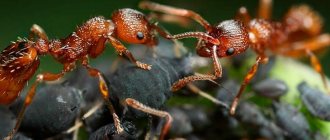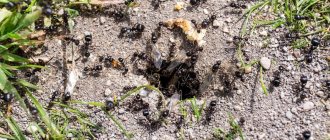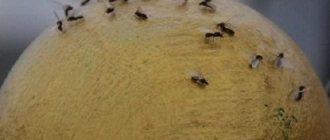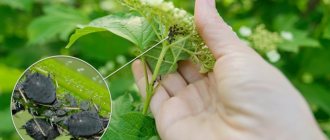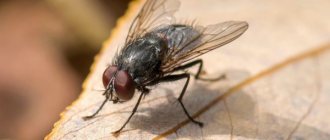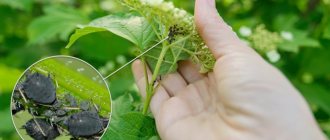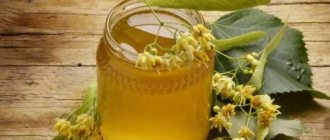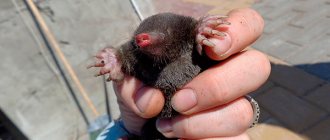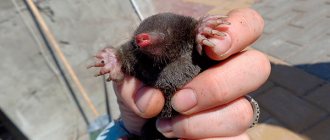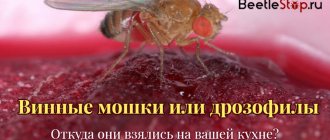Home » Garden and vegetable garden » Other » Pests
Olga Polyakova 06/10/2020
6041 Views 2 comments
Aphids are one of the most common types of insects. In total there are about 4 thousand species of aphids.
Despite external differences, the duration of the life cycle and methods of reproduction, all representatives of aphids have one thing in common - these insects parasitize trees, drinking their juices and spreading various viral infections.
Its fragile body with a weak exoskeleton is damaged by the slightest physical impact; any precipitation in the form of moderate rain can literally wash away the entire aphid colony, leaving no trace of it.
Even ants that protect aphids living in symbiosis with them are not able to repel predators such as ground beetles, lacewings or ladybugs, which “clear” trees of aphids literally within a few tens of minutes. But, despite all this, the aphid lives and thrives, because it has a huge advantage that negates all its weaknesses: a short reproductive cycle (several days) and enormous fertility. Aphids reproduce in almost any conditions (temperature from +12 to +35°C), so theoretically, in 3-4 generations, one insect can give birth to more than a hundred thousand individuals.
Due to the peculiarities of their reproduction, the aphid population is capable of occupying the entire area of the garden in a matter of days and significantly reducing the yield of trees and shrubs. In addition, it makes no difference to a small insect which plant juice to drink - garden, vegetable, greenhouse or indoor, so the fight against aphids is relevant not only for gardeners and gardeners, but also for lovers of indoor floriculture.
Types of aphids and their negative effects
Green aphid
About a third of all aphid species live in Eurasia. The following species are most widespread on the European continent:
- green;
- black;
- cotton;
- Helichrysaceae.
Description of varieties
Black aphid
Representatives of green aphids can be found on any plant. These parasites prefer fruit trees and shrubs, as well as large perennial flowers and herbs. Among garden crops, green aphids mainly attack nightshade plants - they can be found on potatoes and tomatoes.
Black aphids live in vegetable gardens, attacking any low vegetation - from beets to legumes. In addition, aphids attack berry crops and some ornamental plants. Moreover, these crops may not have a garden “registration”. For example, black aphids readily feed on the juice of physalis and tuberous flowers (irises, callas); its larvae can be found on the tender leaves of anemones.
Cotton aphids are also an inhabitant of the vegetable garden. The result of her activities is low yields of melons and pumpkin crops.
Cotton or melon aphid
The cotton aphid poses a particular danger to cucumbers.
Helichrysous aphid
The Helichrys variety prefers crops with large seeds. Trees of the Prunaceae family - plum, sloe, cherry plum, etc. - are primarily at risk. Representatives of this species also suck juice from apple trees, peaches, apricots, viburnum, and linden.
Aphid migration methods
Aphids on garden plants
During the season, aphids do not migrate. Towards the end of summer, the first males appear in aphids and subsequent generations may contain both wingless and winged insects that are already capable of flying from plant to plant.
One of the last generations of aphids, immediately after migrating to a new place, lays eggs, which overwinter and insects emerge from them in the spring, occupying a new “territory.”
Damage from aphids
Large pest colony
Aphids pose a danger to young plants and shoots. By sucking out nutrients and cell juices, it can significantly weaken the plant and slow down its growth rate. In addition, aphid saliva is poisonous to the plant (moreover, it is not the secretions themselves that are poisonous, but the toxins of the fungi that appear on the plants thanks to it).
Its negative impact is complex:
- plant foliage curls and becomes deformed;
- shoots die;
- growth stops.
Viral and fungal diseases can be transmitted from plant to plant through the saliva of aphids. Infections with viral diseases in 90% of cases occur due to aphids. Ants, picking up the sweet secretions of aphids (honeydew) and feeding on them, themselves become carriers of the virus on their paws. Aphids also harm bees, since they can collect its honeydew, mistaking it for nectar.
If you do not use any methods of action against aphids, after 2-3 generations you can forget about a good harvest. Let's look at the various methods for controlling aphids currently in use.
Prevention
To prevent the appearance of black aphids on the site, it is necessary to follow the general rules for the care and prevention of the garden. It is necessary to collect and burn all the weeds and old bark in the fall. Treat plants and trees with a solution of lime at the roots and lower trunk parts. Clean the greenhouses, paint the shabby areas, open the doors for the winter. Treat the soil with insecticides and water with biological preparations for fertilizing.
Attention to your farm and the desire to get a good, healthy harvest motivates the gardener to actively fight pests using the methods described.
5/5 — (1 vote)
Method No. 1: Chemical methods
The use of factory chemicals in the form of an aerosol
One of the most effective ways to kill aphids is the chemical method. Currently, the chemical industry has developed several hundred special products that can quickly destroy insect colonies of any size. In addition, there are about a dozen lines of preventive medications that help prevent insects from appearing in the future.
Let's consider the use of these methods in more detail.
Classification of chemicals
Galls, a frequent companion of aphids
There are three main groups of chemicals used to control aphids. All of them are relatively mild insecticides with little harm to the environment. It is not recommended to use anything more serious (for example, acaricides and other remedies against thrips and ticks). These insects also die when relatively “weak” chemicals are used.
Depending on the type of insecticidal active substance, they are divided into:
- pyrethroids: Decis, Decis Profi, Ariivo, Iskra, Fury, Confidor and other intestinal pesticides, as well as substances of contact and enteric contact action;
- nicotine preparations: Vector, Ratibor, Bombardir, etc.;
- organic phosphorus insecticides: Aktellik, Aktara, Nurel, Fitoverm, Fufanon, Karbofos, etc.;
- biological products (containing bacteria that are pathogenic organisms for insects): Bitoxibacillin, Lepidocid, Bicol, Batsikol, Trichopol.
For direct control of insects, drugs from any of the listed groups are used. They are usually supplied in powder or ampoules. If the recommended doses are followed, the drugs kill insects within 2-4 hours.
For shrubs and small fruit trees, it is recommended to treat plants with systemic phosphorus preparations. It must be carried out before the buds open, that is, such treatment is preventive in nature.
Pyrethroid agents are used after flowering has ended. Nicotinoid preparations are used against aphids, which are located on plants affected by galls - such chemicals can successfully resist both aphids and the cause of the appearance of galls (various parasitic worms, other insects, etc.)
Frequency of chemical use
Insecticide “Aktellik”
If using insecticides it is not possible to completely rid the plants of aphids, they are re-treated. However, there are time restrictions on the use of drugs.
Nicotinoid agents are allowed for re-use no earlier than 21 days after their use. Pyrethroids and organophosphorus compounds - no earlier than after 14 days.
Restrictions on the use of chemistry
Biological products for plant protection
Despite the high efficiency of the chemical method of killing aphids, it has certain disadvantages.
Insecticides in any form are not harmless. In particular, they can cause the death of birds and especially their chicks, which their parents feed intensively in the summer. These products can also be dangerous for humans and care must be taken when working with them. Precautionary measures include protecting the skin, respiratory system and vision.
The main disadvantage of chemicals is limitations in processing during budding, flowering, ovary formation and harvesting.
But theoretically, aphids can appear on plants at any time, and you need to start fighting them as quickly as possible. If the use of insecticides is not possible, other methods of controlling aphids are used.
What harm does
Aphids feed on the cell sap of leaves and young shoots of cherry trees. This leads to disruption of metabolic processes in tree tissue, which negatively affects its development. As a result, the resistance of cherries to unfavorable external factors decreases. This is especially dangerous for young seedlings, since low immunity leads to their death in winter.
Aphids are carriers of various diseases. The most common of them is sooty fungus. It is characterized by a thick black coating on the surface of the leaves. When it appears, the process of photosynthesis is disrupted. As a result, cherries experience a deficiency of nutritional components. Also, sooty fungus is a favorable environment for the development of bacteria, viruses, and infections.
When aphids are infested, the taste of cherry fruits decreases
Method No. 2 Folk remedies
Folk remedies for fighting aphids
Folk remedies for combating these insects mainly consist of spraying the leaves of affected plants with various infusions or decoctions, as well as mechanical and agrotechnical methods of control.
Using infusions
Folk remedies for fighting aphids
This is the simplest, but very effective method of killing insects. It is also not harmless, since high concentrations of certain substances can cause burns in plants and be toxic to both plants and humans.
The use of such a method must be accompanied by compliance with certain rules. In particular, it is recommended to test its effect on a limited area before mass use of a particular composition.
Such products are used once a week. During the periods of flowering and harvesting, their use is acceptable, although undesirable. Application to leaves affected by aphids is done by spraying. This can be either a manual sprayer or a semi-professional sprayer with a pump. It is best to spray in cloudy weather in the evening.
It is possible (but not advisable) to apply the preparations using another means, for example a brush, but their impact will be significantly lower. Any of the listed solutions is effective only when applied evenly to the surface.
Many of these solutions contain soap. This component is required for the following functions:
- Used as an adhesive, “gluing” the surface of the sheet and the active substance, so that it is not washed off with water
- Creates a thin layer of film on the leaves, making them rougher, making it difficult for aphids to pierce them
- Upon contact with the body of an aphid, soap penetrates its trachea, making it difficult for the insect to breathe
Let's look at the most successful recipes for infusions against aphids:
1 Soap solution
Finely chop 100 g of onion and add 2 liters of water, let stand for 3 to 7 hours. Add about 10 g of soap to the resulting infusion.
2 Soap-iodine solution
Dissolve 2 caps of iodine in 5 liters of water and add 50 g of soap shavings (grate on a fine grater). It is recommended to use the mixture no later than half an hour after preparation.
Soap and soda solution
3 Soap and soda solution
Dissolve 2 tablespoons of baking soda (or 1 tablespoon of soda ash) in 2 liters of water. Then rub 15-20 g of laundry or tar soap on a fine grater and add to the mixture. Stir until completely dissolved. This is one of the most effective and long-lasting remedies (about a month), since the presence of sticky drops of soap will help keep the soda on the leaves and stems. Sometimes 30-50 ml of finely crushed wood ash (so-called ash-soap solution) is added to the composition.
4 Soap solution with chamomile
Dry pharmaceutical chamomile (100 g) is poured with a liter of water and left for 12 hours. After this time, another 1 liter of water and 5 g of soap are added to it.
In addition, pepper, dandelion, and marigold infusions are used. For this purpose, 350-400 g of dried stems of the listed plants are used per 1000 ml of water. They can be either with the addition of soap (4-5g per 1 liter of infusion) or without it. Soap containing birch tar is best suited for this purpose.
5 Soapy alcohol solution
Depending on which plants the alcohol mixture is applied to, its recipes may vary. So, for trees the following composition is used:
Add a bottle of vodka (or 200 ml of alcohol) and 30 g of soap shavings to 3 liters of water.
For roses, ornamental and vegetable crops, it is recommended to reduce the amount of vodka to 100 ml, leaving other components in the same quantities.
For indoor plants, a more complex recipe is used: 300 ml of refined vegetable oil, 200 ml of vodka and 20 g of soap are added to 2 liters of water. In this case, the oil acts as a thin film covering the surface of the leaf and preventing aphids from breathing.
6 Vinegar solution
Dissolve 15-30 ml of vinegar essence (or 200-300 ml of 9% table vinegar) in 10 liters of water. Then 50 g of soap shavings are added to the mixture.
7 Hydrogen peroxide
An effective remedy not only against aphids, but also mealybugs and scale insects. Particularly effective for treating indoor plants.
Compound:
- hydrogen peroxide 3% – 50 ml;
- vodka – 2 teaspoons ml (or alcohol – 1.5 tsp);
- dishwashing liquid – 1 g;
- water – 1 l.
The mixture should be used within 10-15 minutes after preparation; it cannot be stored longer.
Garlic water
8 Garlic solution
Garlic cloves (100 g) are finely chopped and immersed in 500 ml of water, allowing to brew for about 72 hours. Before you start treating the plants, you need to dilute a solution of garlic cloves in water in a concentration of 300 to 1.
9 Tobacco leaves
Dried tobacco stems and leaves weighing 100 g are finely chopped and poured into 3 liters of water for 48 hours. At the end of the infusion, you need to add another 2 liters and spray the affected plants with the resulting solution. This solution can also be made ash by adding 100 ml of wood ash to it.
10 Pine needles
Pine needles in an amount of 2 kg are filled with water (one bucket). The infusion requires regular daily stirring for a week. At the end of this period, you need to add the same amount of water to the container and use it for spraying.
11 Citrus infusion
Aphids do not tolerate the smell of citral aldehyde well, so they are well repelled by any aromatic or essential oil from the peel of citrus fruits. Dried peel of lemon, orange, and other similar crops in the amount of 100 g are infused in 1 liter of water for 3 days.
The product has high chemical activity, so it must be used in small doses. To treat one plant up to 2 m high, use approximately one glass (230-250 ml) of this liquid product.
Citrus tincture
12 Nightshade infusion
Nightshade leaves and shoots (1 kg) are finely chopped and immersed in 10 liters of water for at least 3 hours. Can be used as an independent remedy or in a 1 to 1 mixture with a soap solution.
13 Infusion of sorrel root
200 g of sorrel root is immersed in 3 liters of hot water, where it is infused for at least 3 hours. Since the main component of the product is an acid, it is not recommended to mix it with soda or soap.
14 Acid-ammonia solution
It has a quick action time, although it is completely inapplicable for prophylaxis. This product works great on roses and rose hips. Helps fight aphids also on currants and other ornamental bushes.
Compound:
- 2% salicylic acid solution – 25 ml;
- ammonia alcohol – 15 ml;
- water – 500 ml.
All components are mixed until smooth, and then the affected plant is sprayed. Immediately before treating the plant and 30 minutes after that, it is subjected to sprinkling.
15 Use of natural pyrethroids
Dalmatian chamomile leaves contain a large amount of natural insecticides that will be effective at all stages of insect development. To preserve these abilities, it is not recommended to heat treat the leaves and buds of the plant. They should be dried and thoroughly crushed. Then the crushed leaves are poured with water and allowed to brew for about a week. For 1 liter of infusion, 5 tsp is enough. dry chamomile leaves.
Before use, strain the infusion and add a little soap to it. You can also prepare a remedy from fresh leaves, for which they should first be doused with boiling water, and only then crushed and filled with water. This will require approximately 3 times the amount of biomass.
When growing independently, it is recommended to plant Dalmatian chamomile on the leeward side of the site.
Prevention when using solutions
Garlic for aphids - application
Low concentration infusions can act as a prophylactic agent. They are used by diluting with water in a ratio of 1 to 1. For prevention, it is recommended to treat the stems and leaves of the plant once a week.
Soap-containing solutions remain on the leaves for a much longer time. They are recommended to be used for prevention once every two weeks.
Use of decoctions
Preparation of a decoction of celandine
Decoctions are more effective because they contain an even higher concentration of active substances. Their harmful effects will be even greater than those of infusions, however, the effect will also be more significant. Decoctions are used in particularly advanced cases, when the population of aphid colonies is high.
Recipes for the most common decoctions:
- The stems and flowers of freshly collected celandine (800 g) are immersed in 2 liters of water and infused for 24 hours. Next, the resulting mixture is boiled for half an hour
- One hundred grams of dried tobacco leaves are poured into 3 liters of water and left for a day. Next, add another 2 liters of liquid to the infusion, bring it to a boil over low heat and leave for another 2 hours.
- Nightshade stems and leaves in an amount of 500 g are placed in a 3-liter container with boiling water. Boiling is continued for about half an hour. Pour another 5 liters of water into the resulting broth and add 30 g of laundry soap.
- It is also possible to prepare a similar mixture from potato peels, but it will require 2 times more than tomato tops in the previous version
- A decoction of onion peels is prepared in a similar way. It is taken in an amount of 600-800 g and placed in 3 liters of boiling water. Boiling is carried out for 15-20 minutes, after which the husks are thrown away, the broth is filtered, diluted with another 3 liters of water and 50 g of soap shavings are added.
- One hundred grams of hot pepper fruits are boiled for 60 minutes in 1 liter of water. The resulting mixture needs to be infused for two days in a warm and cool place. After infusion is complete, the concentrate is filtered and diluted with water in a ratio of 1 to 10. It is also recommended to add 5 g of soap to the resulting composition
- Dried yarrow in the amount of 500 g is poured into 1 liter of water. The resulting composition should be placed in a water bath for half an hour, then add another 4 liters of water and leave for 24 hours
Other methods
Aphids on roses
Mechanical methods are used when the aphids are still small (3-4 lesions with several dozen individuals). They involve manually collecting insects and their eggs or cutting and destroying affected leaves.
For indoor flower plants at home, traps are used - protection from aphids in the form of a barrier on the stems. As such a barrier, special adhesive tapes with a width of 40 mm or more are used. There are also wider adhesive tapes that fit onto the trunks of large trees. Such remedies will be effective only at the beginning of the season, while insects do not have wings for flight.
Agrotechnical methods (weeding beds, loosening, killing weeds, introducing ash into the soil, fumigating with sulfur, etc.) should be carried out regularly at least once a week. Mulching eliminates these procedures for an additional week. Do not forget to sprinkle crops from time to time - a stream of water from the plants can wash away most of the aphid colonies.
It is important to remember that watering plants with cold tap water from a hose is also not recommended - they weaken and lose immunity not only to aphids, but also to other malicious pests.
Sometimes methods are used to repel aphids by scattering various substances with a pungent odor on the site. In particular, it is recommended to place bay leaves in the spaces between the rows of the beds where bell peppers or various types of cabbage grow. Instead, shag can be used; it is also recommended to pollinate the plants with dry tobacco dust, use dried dandelion powder, etc. But the effectiveness of such methods will be low, since over time the smell will disappear and the repellent material will have to be constantly updated.
What kind of pest is this
The body of the pest resembles the shape of a hemisphere or an egg. Aphids can grow up to 0.3-0.8 mm. The integument of the body is transparent and soft. On the surface of the body there are tubercles and hairs of varying lengths.
The aphid's oral apparatus is a proboscis, with the help of which the parasite is able to pierce the surface tissue of the plant and get to the sap. Aphids prefer to be located on the underside of leaf blades, stems and the tops of young shoots.
Note! Aphids secrete a sweet liquid that attracts ants.
Method No. 3 Biological methods
Biological control methods
Biological methods of controlling aphids are no less common. Like any living creature, aphids can either be diverted from their food supply or destroyed by natural enemies.
These methods of control are completely harmless to people and crops grown in the garden, since they are based on natural processes, so it is recommended to resort to them first.
Using repellers
Marigolds are the best repeller of many pests
Use of repellers These can be plants that have in their juices a sufficient amount of active organic compounds that have a persistent odor. They are planted quite densely along the paths of possible migration of aphids - along the edges of the beds, along the perimeter of the site, in the rows, etc.
Such plants include:
- onion;
- garlic;
- mint;
- mustard;
- fennel;
- coriander;
- pharmaceutical camomile;
- marigold;
- daisies;
- lavender;
- cosmos;
- tansy
- and etc.
Using Attractors
Leguminous plants attract pests
Using attractors This method uses the opposite principle of influencing insects. Instead of distracting aphids from a potential “prey”, they attract them to other plants that are not of agricultural importance.
These include:
- begonia;
- sleeping pills;
- nasturtium;
- cleome;
- legumes;
- mallow;
- and so on.
Unlike repellers, which are located at the borders of plots or next to the protected crop, attractor plants are planted away from the main crops, but in fairly large groups. It would be a good idea to plant such plants on the leeward side.
Use of predators
Biological methods of controlling aphids
Use of Predators Among animals, aphids are at the very bottom of the food chain. Due to the lack of natural protection, it is the food of many species, mainly insects and birds. Predators betray aphids, despite the active resistance of the ants. Sometimes the damage is so great that it will take several days or even weeks for the aphid population to recover.
Therefore, there is no need to destroy the ant colony located next to the site. Several thousand of these insects in an anthill will bring much more benefit, and with the right approach, the aphids will be forced to switch to crops that have no economic or decorative value.
Natural enemies of aphids are:
- ladybugs and their larvae;
- ground beetles;
- riders;
- hoverflies;
- wrens;
- earwigs;
- predatory bugs;
- small birds - sparrows, tits, robins, wrens, linnets, etc.
You can attract insects to the area if you plant fragrant plants - parsley, dill and carrots. To attract birds, it is necessary to equip the site with houses in the form of birdhouses and nest boxes, as well as placing feeders and drinking bowls on it.
Damage to cucumbers
An aphid invasion is observed in the second half of summer. At the end of July, aphids actively reproduce and are located in entire colonies on the underside of leaf blades. The pest causes damage to cucumber bushes and causes:
- yellowing and curling of leaf plates;
- slowing down the growth of vegetable crops;
- loss of green space vigor;
- lack of ovary;
- death of bushes;
- falling off of developing fruits.
Aphids secrete sugary juice, which promotes gluing of leaf plates. The liquid attracts various garden pests.
Grape phylloxera
The body is oval, yellow or brown in color. The antennae and proboscis are very short.
- Geographical distribution. Viticulture areas in Europe, North America, Africa and Asia.
- On what plants is it found? Lives only on all types of grapes. The leaf form does not settle on pubescent varieties.
- Development. Root and leaf forms go through a full cycle. One leafy female can produce up to 500 eggs. Up to 9 generations change per season.
- What harm does it cause? Phylloxera is a quarantine pest. Galls appear on the roots and deformation appears on the leaves. The population is capable of completely destroying the vineyard.
Rose green
All forms and stages of development are not very different from each other. Any individual has an ellipsoidal green body , long brown antennae, and a sword-shaped elongated tail.
- Geographical distribution. Lives almost everywhere.
- On what plants is it found? In addition to roses and rose hips, aphids can settle on strawberries, pears and apple trees.
- Features of development. It goes through a full cycle. Overwinters on branches in the egg stage. Foundresses produce an average of about 80 eggs each. It reproduces in greenhouses and conservatories all year round.
- What harm does it cause? The growth of bushes is inhibited, the leaves curl, the buds do not open, weakened plants do not tolerate winter cold and virus attacks.
Cucumber (melon)
The elongated body with a sharp rear tip is colored in different shades of green. The antennae and paws are black.
Melon aphid photo.
- Geographical distribution. Everywhere.
- On what plants is it found? Melons, cucumbers, beets, cotton, tobacco, peanuts, sesame, citrus fruits, eucalyptus.
- Features of development. Parthenogenetic reproduction, development is incompletely cyclical. Several generations of asexual virgins change over the course of a season. Fertility - 40-50 individuals per female.
- Harm caused. This variety is one of the most harmful. Causes great damage to plants due to high fertility.
Hermes
The founder has a black shiny body. Subsequent generations are covered with white fluffy hairs.
- Geographical distribution. Everywhere where there are coniferous trees.
- On what plants is it found? Any conifers, especially spruce, pine, larch and cedar.
- Development. Incomplete. 4-5 generations appear per season.
- Maliciousness. They disrupt the development and fruiting of trees, weakening their protective abilities and reducing their decorative properties.
Mealy (hairy)
The wingless female has a pinkish-cream body and an oval shape. There are numerous bristles on the sides. The entire body is covered with a snow-white coating, reminiscent of flour.
The winged female differs from the wingless one only in the presence of wings.
- Geographical location. Everywhere.
- On what plants is it found? Prefers citrus fruits, grapes, most indoor and greenhouse plants.
- Development. The female can lay up to 2 thousand eggs, from which larvae soon emerge. They are mobile and spread over all surrounding plants, sucking the juice from them. At home and in greenhouses, development and reproduction are continuous.
- Maliciousness. Deformation of branches and stems, drying and falling of buds and leaves, inhibition of development, weakening of the protective qualities of plants.
Reasons for the appearance of black aphids on cherries
Before you fight aphids on cherries, you need to pay attention to the causes of tree infestation. The main reasons for cherry aphid infestation are:
• a large number of weeds around the tree; • colonies of ants living nearby; • weak plant immunity.
An unkempt garden with a lot of weeds will quickly lead to the appearance of various diseases. Winged aphids can reproduce on weeds in early spring, and then transfer their relatives to cherries in June, when cherries are in fruiting period.
Aphid colonies would not be able to develop quickly without the ants. The wingless aphid would be destroyed by other insects or would die from lack of food. Winged aphids reproduce poorly and would not be able to restore the colony. The wingless subspecies cannot move normally around the plant without ants.
Home or room
Includes several subspecies that differ in color. There are white aphids, red aphids, and there are also green and black aphids.
- Geographical location. Everywhere.
- On what plants is it found? On almost all indoor flowers.
- Development. Full cycle. Reproduction is parthenogenetic and amphigonic individuals mate periodically. They do not go to winter and develop all year round.
- Maliciousness. Leaves, shoots and buds wither and dry out and fall off. Plants stop developing and gradually die.
Cabbage
It has a broad oval pale green body and short dark antennae.
Cabbage aphid photo.
- Geographical distribution. In almost all countries, in Russia it is absent in subtropical regions.
- On what plants is it found? It lives mainly on cruciferous vegetables, especially likes radishes and cabbage.
- Development. In warm climates, development is incomplete, in other areas - a full cycle. During the season, from 6 to 30 generations appear.
- What harm does it cause? Reproducing en masse, it adheres to the entire plant, which leads to death.
Carrot
The elongated oval body is pale green in color, the antennae are short and light, as are the paws.
- Geographical distribution. Everywhere.
- On what plants is it found? On carrots and other umbrella plants.
- Development. Full life cycle.
- What harm does it cause? The leaves curl, the nutrition of root crops deteriorates, so the quality and quantity of the harvest suffers.
Beet or bean
The egg is black, elliptical . The founder and the wingless virgin have an oval body, widened at the sides.
It is colored brown, black or green, covered with a wax-like coating. Winged individuals have a black head, antennae and chest, and a lighter belly.
- Geographical distribution. Europe, North America, Central Asia and Transcaucasia.
- On what plants is it found? Prefers beets, jasmine, euonymus, beans, poppy, viburnum, spring vetch, sunflower and potatoes.
- Features of development. Alternation of generations throughout the growing season of food plants, the last generation mates and lays wintering eggs.
- What harm does it cause? The leaves wrinkle and curl, the plant is stunted in growth and may die. Carries various viral diseases.
Tips from summer residents
Experienced gardeners and farmers share recommendations for effectively combating black aphids on cucumbers :
- Inspect the bushes regularly, especially the back of the leaves. At the slightest sign of damage, start irrigating the plants with folk remedies.
- If homemade infusions and solutions do not produce results, switch to chemical and biological agents.
- Regularly feed cucumbers with a potassium-phosphorus mixture.
- At the same time, wage a “war” with the ants, otherwise the aphids will return again and again.
- Weed the beds from time to time.
- Remove affected parts of the plant and burn immediately.
- Rinse the bushes with water from a hose before flowering begins.
